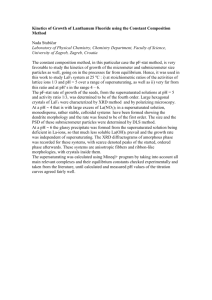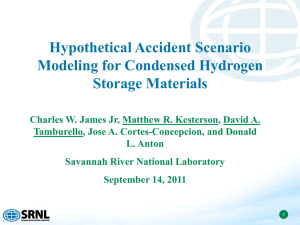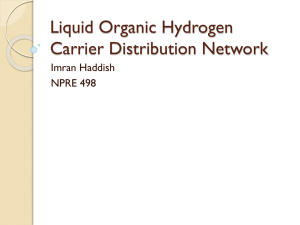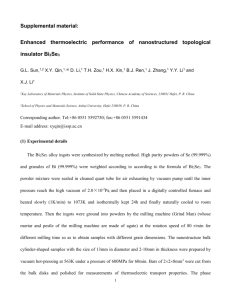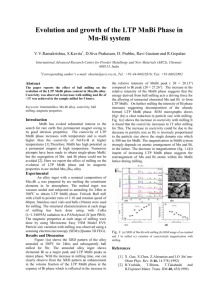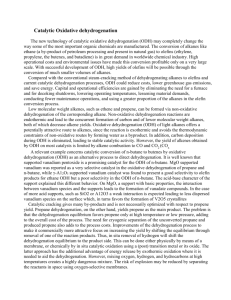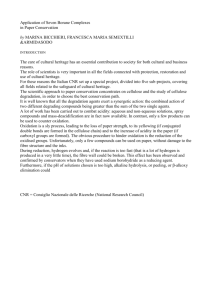synthesis and characterisation of New amidoboranes
advertisement
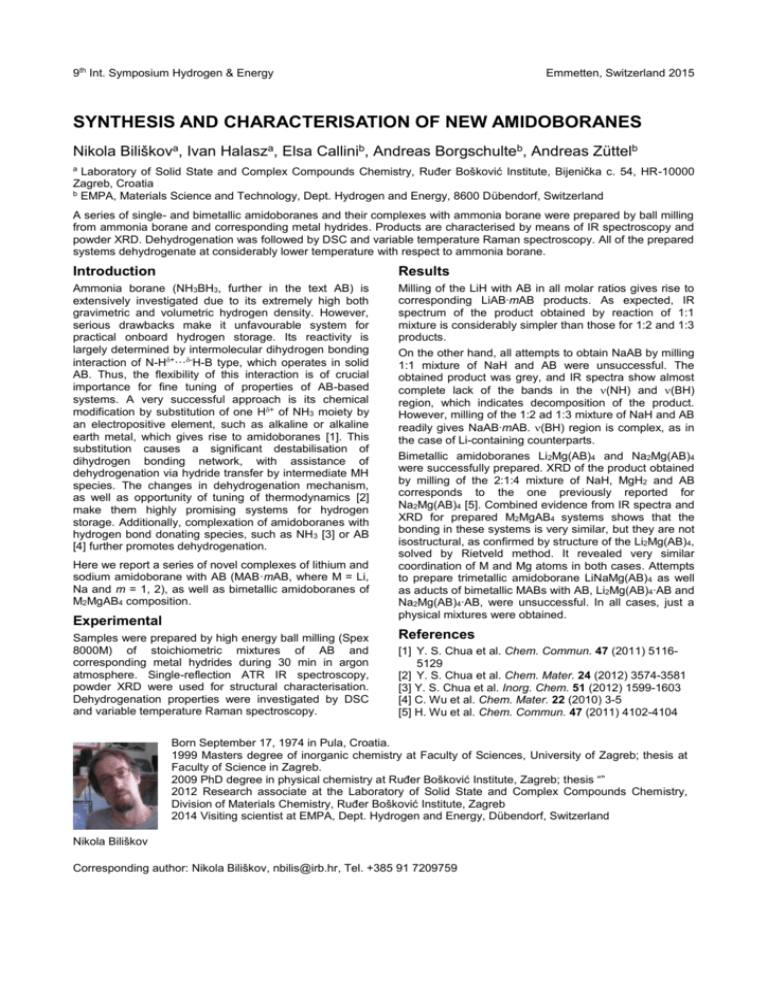
9th Int. Symposium Hydrogen & Energy Emmetten, Switzerland 2015 SYNTHESIS AND CHARACTERISATION OF NEW AMIDOBORANES Nikola Biliškova, Ivan Halasza, Elsa Callinib, Andreas Borgschulteb, Andreas Züttelb Laboratory of Solid State and Complex Compounds Chemistry, Ruđer Bošković Institute, Bijenička c. 54, HR-10000 Zagreb, Croatia b EMPA, Materials Science and Technology, Dept. Hydrogen and Energy, 8600 Dübendorf, Switzerland a A series of single- and bimetallic amidoboranes and their complexes with ammonia borane were prepared by ball milling from ammonia borane and corresponding metal hydrides. Products are characterised by means of IR spectroscopy and powder XRD. Dehydrogenation was followed by DSC and variable temperature Raman spectroscopy. All of the prepared systems dehydrogenate at considerably lower temperature with respect to ammonia borane. Introduction Results Ammonia borane (NH3BH3, further in the text AB) is extensively investigated due to its extremely high both gravimetric and volumetric hydrogen density. However, serious drawbacks make it unfavourable system for practical onboard hydrogen storage. Its reactivity is largely determined by intermolecular dihydrogen bonding interaction of N-H+···-H-B type, which operates in solid AB. Thus, the flexibility of this interaction is of crucial importance for fine tuning of properties of AB-based systems. A very successful approach is its chemical modification by substitution of one H+ of NH3 moiety by an electropositive element, such as alkaline or alkaline earth metal, which gives rise to amidoboranes [1]. This substitution causes a significant destabilisation of dihydrogen bonding network, with assistance of dehydrogenation via hydride transfer by intermediate MH species. The changes in dehydrogenation mechanism, as well as opportunity of tuning of thermodynamics [2] make them highly promising systems for hydrogen storage. Additionally, complexation of amidoboranes with hydrogen bond donating species, such as NH3 [3] or AB [4] further promotes dehydrogenation. Milling of the LiH with AB in all molar ratios gives rise to corresponding LiAB∙mAB products. As expected, IR spectrum of the product obtained by reaction of 1:1 mixture is considerably simpler than those for 1:2 and 1:3 products. On the other hand, all attempts to obtain NaAB by milling 1:1 mixture of NaH and AB were unsuccessful. The obtained product was grey, and IR spectra show almost complete lack of the bands in the (NH) and (BH) region, which indicates decomposition of the product. However, milling of the 1:2 ad 1:3 mixture of NaH and AB readily gives NaAB∙mAB. (BH) region is complex, as in the case of Li-containing counterparts. Bimetallic amidoboranes Li2Mg(AB)4 and Na2Mg(AB)4 were successfully prepared. XRD of the product obtained by milling of the 2:1:4 mixture of NaH, MgH2 and AB corresponds to the one previously reported for Na2Mg(AB)4 [5]. Combined evidence from IR spectra and XRD for prepared M2MgAB4 systems shows that the bonding in these systems is very similar, but they are not isostructural, as confirmed by structure of the Li2Mg(AB)4, solved by Rietveld method. It revealed very similar coordination of M and Mg atoms in both cases. Attempts to prepare trimetallic amidoborane LiNaMg(AB)4 as well as aducts of bimetallic MABs with AB, Li2Mg(AB)4∙AB and Na2Mg(AB)4∙AB, were unsuccessful. In all cases, just a physical mixtures were obtained. Here we report a series of novel complexes of lithium and sodium amidoborane with AB (MAB·mAB, where M = Li, Na and m = 1, 2), as well as bimetallic amidoboranes of M2MgAB4 composition. Experimental Samples were prepared by high energy ball milling (Spex 8000M) of stoichiometric mixtures of AB and corresponding metal hydrides during 30 min in argon atmosphere. Single-reflection ATR IR spectroscopy, powder XRD were used for structural characterisation. Dehydrogenation properties were investigated by DSC and variable temperature Raman spectroscopy. References [1] Y. S. Chua et al. Chem. Commun. 47 (2011) 51165129 [2] Y. S. Chua et al. Chem. Mater. 24 (2012) 3574-3581 [3] Y. S. Chua et al. Inorg. Chem. 51 (2012) 1599-1603 [4] C. Wu et al. Chem. Mater. 22 (2010) 3-5 [5] H. Wu et al. Chem. Commun. 47 (2011) 4102-4104 Born September 17, 1974 in Pula, Croatia. 1999 Masters degree of inorganic chemistry at Faculty of Sciences, University of Zagreb; thesis at Faculty of Science in Zagreb. 2009 PhD degree in physical chemistry at Ruđer Bošković Institute, Zagreb; thesis “” 2012 Research associate at the Laboratory of Solid State and Complex Compounds Chemistry, Division of Materials Chemistry, Ruđer Bošković Institute, Zagreb 2014 Visiting scientist at EMPA, Dept. Hydrogen and Energy, Dübendorf, Switzerland Nikola Biliškov Corresponding author: Nikola Biliškov, nbilis@irb.hr, Tel. +385 91 7209759
